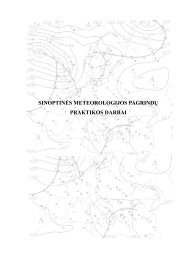1 doc. Egidijus Rimkus, prof. Arūnas Bukantis, doc. Gintautas ...
1 doc. Egidijus Rimkus, prof. Arūnas Bukantis, doc. Gintautas ...
1 doc. Egidijus Rimkus, prof. Arūnas Bukantis, doc. Gintautas ...
Create successful ePaper yourself
Turn your PDF publications into a flip-book with our unique Google optimized e-Paper software.
as many as 29 days – dates of the permanent temperature transition through 0 °C were shifted closer<br />
to midwinter period. Moreover at the end of the 20 th century, the number of extremely cold days<br />
(Tmin ≤ -20 °C) has decreased whereas the frequency of hot days (Tmax ≥ 25 °C) – increased.<br />
Precipitation rate in the cold season tend to increase and in the warm season – decrease because of<br />
the more intense cyclonic activity in Baltic region in winter and more frequent quasi stationary<br />
anticyclones – in summer. The number of days with precipitation in winter also increased. Besides<br />
the precipitation type in winter has been changed – increased liquid precipitation fraction.<br />
Climate studies showed that the last decade of 20 th century distinquished by unique<br />
climatic phenomenon on several successive extremely warm winters (1988/1989 – 1994/1995) –<br />
Eastern Europe has never evidenced such a long series of exceptionally positive anomalies.<br />
According to the results of simulations based on six climate models used worldwide<br />
(HadCM2, ECHAM4, CGCM1, GFDL-R30, CSIRO-Mk2 and CCSR/NIES) air temperature in<br />
Lithuania has to increase in the 21 st century. December- March temperatures should experience the<br />
highest rate of change during first half of this century. In the second half December temperatures<br />
increase rate will slow down but February temperatures at the end of the century should be by 4-6<br />
°C higher. So forecasts coincide with the current climate change tendencies in Lithuania and show<br />
the regional climate to become more marine type. Climate models give rather different results for<br />
precipitation rate. All models simulate increasing precipitation rate on average but precipitation in<br />
cold season should increase faster than in warm one, also interseasonal differences have to decrease.<br />
Summarizing it is evident that together with the change of the regional hydrothermal<br />
conditions there should be the substantial shift in mean dates and duration of seasons, in snow<br />
depth, hydrological regime of rivers and reservoirs, agricultural works. From the other hand the<br />
rising number of extreme weather like hurricane strength cyclones, droughts, floods, hot waves and<br />
cold outbreaks should bring outspread damages in agriculture, industry, recreation and life quality.<br />
Šis straipsnis skelbtas žurnale „Geologijos akiračiai“:<br />
<strong>Rimkus</strong> E., <strong>Bukantis</strong> A., Stankūnavičius G. (2006). Klimato kaita: faktai ir prognozės. Geologijos akiračiai, 1 (61):<br />
10-20.<br />
18



